World Economic Outlook
Mild Slowdown of the Global Expansion, and Increasing Risks
June 2011
Activity is slowing down temporarily, and downside risks have increased again. The global expansion remains unbalanced. Growth in many advanced economies is still weak, considering the depth of the recession. In addition, the mild slowdown observed in the second quarter of 2011 is not reassuring. Growth in most emerging and developing economies continues to be strong. Overall, the global economy expanded at an annualized rate of 4.3 percent in the first quarter, and forecasts for 2011–12 are broadly unchanged, with offsetting changes across various economies. However, greater-than-anticipated weakness in U.S. activity and renewed financial volatility from concerns about the depth of fiscal challenges in the euro area periphery pose greater downside risks. Risks also draw from persistent fiscal and financial sector imbalances in many advanced economies, while signs of overheating are becoming increasingly apparent in many emerging and developing economies. Strong adjustments—credible and balanced fiscal consolidation and financial sector repair and reform in many advanced economies, and prompter macroeconomic policy tightening and demand rebalancing in many emerging and developing economies—are critical for securing growth and job creation over the medium term.
The global economy has continued to expand
Despite some negative surprises, global growth attained an annualized rate of 4.3 percent in the first quarter of 2011, broadly as expected in the April 2011 World Economic Outlook (Figure 1: CSV|PDF, top panel; Table 1). The outturn was underpinned by many unanticipated offsetting factors. Key among the negative surprises was the devastating effect of the earthquake and tsunami on the Japanese economy, with supply disruptions weighing heavily on industrial production, and consumer sentiment and spending. Growth also disappointed in the United States, in part due to transitory factors—including higher commodity prices, bad weather, and supply chain disruptions from the Japanese earthquake on U.S. manufacturing. In contrast, growth surprised on the upside in the euro area, powered by more upbeat investment in Germany and France. Growth in emerging and developing economies evolved as expected, but with considerable variation across regions. Global employment continued to pick up, including in many advanced economies (Figure 2: CSV|PDF).
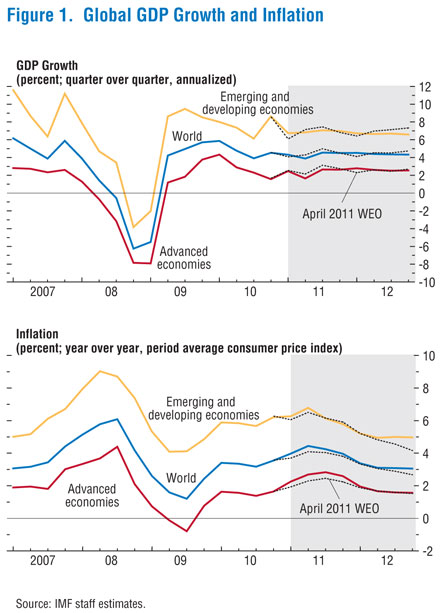
Inflation has risen
Global inflation picked up from 3½ percent in the last quarter of 2010 to 4 percent in the first quarter of 2011, more than ¼ percentage point higher than projected in the April 2011 World Economic Outlook (Figure 1: CSV|PDF, bottom panel). Inflation accelerated mainly because of larger-than-expected increases in commodity prices. However, core inflation also crept up across a number of economies. Among advanced economies, core inflation remained subdued in the United States and Japan and rose moderately in the euro area. Among emerging and developing economies, inflation pressures have become increasingly broad-based, reflecting a higher share of food and fuel in consumption as well as accelerating demand pressure.
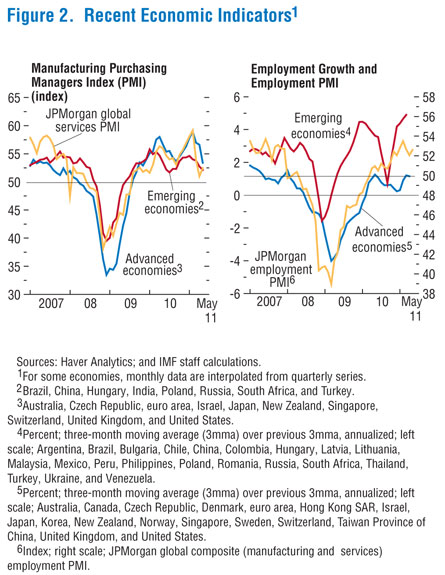
Financial volatility has increased
After easing through much of the first half of 2011, global financial conditions have become more volatile since late May (Figure 3: CSV|PDF). This reflects market concerns about sovereign risks related to developments in the euro area periphery and the recent softening in activity and persistent housing market weakness observed in the United States. Symptoms include rising sovereign credit default swap spreads in certain euro area economies, retreating global stock prices, and falling long-term bond yields in the major advanced economies. In addition, the June 2011 Global Financial Stability Report (GFSR) Market Update emphasizes the insufficient pace of progress on banking system repair, notably in Europe, as well as risks related to releveraging in various market segments.
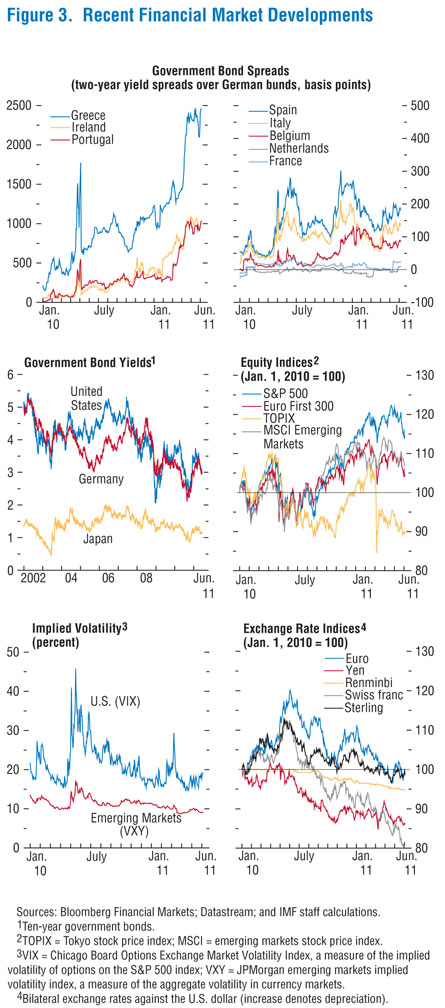
For emerging and developing economies, the financial environment remains quite accommodative, although with greater variation across countries. Capital inflows have been fickle (Figure 4: CSV|PDF), probably reflecting the increased downside risks to the global economy and domestic policy concerns such as inflation. Some of the larger economies are experiencing rapid credit growth, propelled by accommodative macroeconomic conditions and buoyant capital flows (Figure 5: CSV|PDF). In others, credit growth has decelerated with a persistent tightening of monetary policy. Despite some currency gyrations (Figure 3: CSV|PDF, bottom panel), exchange rates have not moved much in real effective terms in recent months.
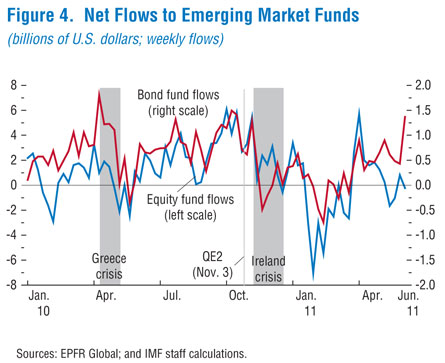
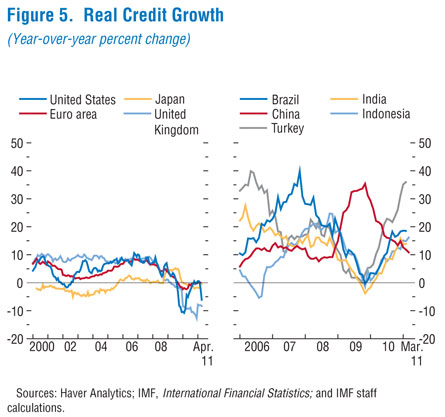
Commodity prices have stabilized
Commodity markets have experienced volatility since late April (Figure 6: CSV|PDF). After surging through April, commodity prices fell in May. The corrections partly reflected the unwinding of an earlier buildup of noncommercial derivative positions with increased general financial volatility and in reaction to recent data on softer global economic activity. Prices of crude oil briefly came close to $120 a barrel in April, fell sharply in May, but have stabilized since. Current prices average about $107 a barrel, close to levels assumed in the April 2011 World Economic Outlook. Food prices also stabilized beginning in early 2011, following last year’s weather-related supply shocks.
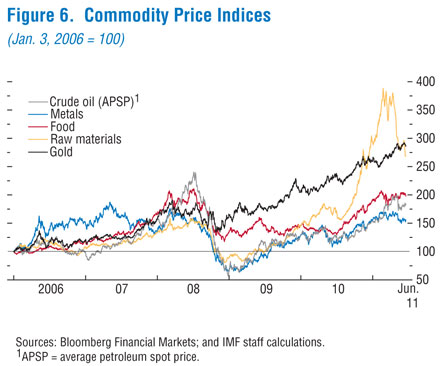
Growth will slow temporarily
Global activity is projected to slow in the second quarter of 2011, and then reaccelerate in the second half of the year. But activity will remain unbalanced amid elevated downside risks. Growth is set to be sluggish in advanced economies facing fiscal and financial sector balance sheet problems, which will continue to be a drag on employment. Activity will continue to expand strongly in advanced economies that do not face such challenges, as well as in many emerging and developing economies.
Forward-looking indicators such as manufacturing purchasing managers indices suggest that activity has softened in the second quarter of 2011, especially in many advanced economies. The projected easing in activity comes from more subdued private consumption, as oil price hikes in previous quarters cut into households’ real incomes. In addition, the effect of global supply disruptions from the Japanese earthquake is fully materializing in the second quarter. However, the fundamental drivers of growth remain in place: overall still-accommodative macroeconomic conditions, pent-up demand for consumer durables and investment, and strong potential growth in emerging and developing economies. Accordingly, the baseline projections on global growth and inflation remain broadly unchanged compared with the April 2011 World Economic Outlook (Table 1).
Growth in the advanced economies is projected to average about 2½ percent during 2011–12, slightly weaker than in the April 2011 World Economic Outlook. This would represent a modest deceleration from an average of about 3 percent in 2010. For 2011, growth is expected to be weaker than previously projected in the United States and Japan, partly offset by stronger activity in core euro area economies. In 2012, the rebound of the Japanese economy from the earthquake is forecast to offset weaker growth in the United States.
Output growth in emerging and developing economies is expected to be 6½ percent during 2011–12, compared with about 7½ percent in 2010, in line with the April 2011 World Economic Outlook projections. Within this overall picture, prospects vary across regions. Growth in emerging Asia will decelerate only slightly from the very high levels of last year. Disruptions to regional production networks due to supply constraints from Japan appear contained, although some sectors, especially automobiles and electronics, could experience strains through the summer. Latin America will be bolstered by commodity exports and domestic demand but the pace will ease in some economies where policies have been tightening more aggressively (see box). Growth in emerging Europe is now projected to be higher than previously expected in 2011, followed by a softening in 2012, driven in part by a sharp domestic demand cycle in Turkey. Activity is projected to continue strengthening in sub-Saharan Africa, with domestic demand remaining robust and commodity exporters benefiting from elevated prices. Economic prospects in the Middle East and North Africa remain clouded by political and social unrest, although the outlook has improved for some oil and mineral exporters.
Increasing downside risks
The balance of risks points down more than at the time of the April 2011 World Economic Outlook. Downside risks due to heightened potential for spillovers from further deterioration in market confidence in the euro area periphery have risen since April (see the June 2011 GFSR Market Update). Market concerns about possible setbacks to the U.S. recovery have also surfaced. If these risks materialize, they will reverberate across the rest of the world—possibly seriously impairing funding conditions for banks and corporations in advanced economies and undercutting capital flows to emerging economies. In addition, banks in advanced economies continue to face a wall of refinancing requirements, and a squeeze on banks’ wholesale funding could reverse the recent normalization of lending standards. Near-term risks for sharper or more drawn-out negative spillovers from Japan to other economies cannot be ruled out either.
| Economic Outlook for Latin America and the Caribbean Growth remains robust in Latin America and the Caribbean (LAC) and is projected to exceed 4½ percent in 2011. The expansion has been strongest in South America, where high commodity prices and easy external financing conditions are fueling domestic demand, which, if left unchecked, could soon lead to overheating. The recovery in many Central American and Caribbean countries has gained some strength, although growth continues to be constrained by strong real links with slower-growing advanced economies (particularly the United States), less favorable terms of trade, and in some cases high public debt. Latin America recovered quickly and strongly from the global financial crisis. In most countries, prudent, countercyclical policies in the years leading up to the crisis allowed the deployment of macroeconomic stimulus to counteract its effects on activity. The region expanded by more than 6 percent in 2010, led by South America, where high commodity prices, easy external financing conditions, and accommodative macroeconomic policies stimulated domestic demand. Output gaps have closed in much of the region and early signs of overheating are appearing: inflation is rising, current account deficits are widening, and credit and asset prices are growing rapidly. Rising global fuel and food prices are adding to the challenge of containing inflation and protecting the poor. LAC growth is projected to moderate to about 4½ percent in 2011 and to converge to its potential rate, about 4 percent, over the next two years. The expansion will continue to be led by domestic demand, and accompanied by a further widening in the current account deficit. This baseline scenario assumes a significant withdrawal of policy stimulus and some deceleration of private sector demand, particularly for large commodity exporters. There are signs that activity is finally gaining traction in economies with closer real links to advanced economies, where the recovery has lagged. However, growth in many Central American and Caribbean countries will continue to be constrained by the slow recovery in remittances and tourism and less favorable terms of trade. High public debt will require sustained fiscal consolidation in the Caribbean, which will also pose a drag on growth. Although downside risks persist for the world economy, risks for the near-term outlook in Latin America are somewhat more balanced. GDP growth could be higher if the assumed policy tightening does not materialize or proves insufficient to slow domestic demand. Under this scenario, however, inflation and current account deficits could turn out higher than projected, raising the risk of boom-bust dynamics. On the downside, a serious tightening in global financial conditions could lead to a reversal in inflows to the region and adversely affect its prospects. With output gaps closed in most countries, macroeconomic policy accommodation should be removed. Even though many countries have moved in recent months to raise policy interest rates, it is still critical to continue to adjust the policy mix by reducing the pace of government spending to avoid placing an excessive burden on monetary policy in the context of sizable capital inflows and currency appreciation. In light of strong credit and asset price growth, countries should also continue to strengthen macroprudential measures and possibly use capital controls to enhance the resilience of their financial systems. In Central America, emphasis must shift to rebuilding the policy buffers used during the global recession, while in the Caribbean, where public debt is very high, fiscal policy will need to continue with consolidation to ensure economic stability and set the stage for sustainable growth in the future.
|
||||||||||||||||||||||||||||||||||||||||||||||||||||||||||||||||||||||||||||||||||||||||||||||||||||||||||||||||||||||||||||||||||||||||||||||||||||||||||||
Regarding commodities, risks are smaller than projected in April but still point down for growth. Unrest in the Middle East may raise oil prices. Although pressures in food markets have eased somewhat, low inventories and weather-related supply disruptions present significant near-term upside risk for prices.
Fiscal challenges continue to pose various risks for the recovery. A first set of concerns revolves around fiscal imbalances in the euro area periphery. A second set involves the large near-term fiscal adjustment in the United Sates against a still-fragile recovery. A third set of concerns centers on medium-term fiscal sustainability in the United States and Japan. In the United States, these risks are rising because of the absence of credible consolidation and reform plans, while Japan’s plans must be made sufficiently ambitious and be implemented. In Japan, the fiscal response to the earthquake has raised challenges to attaining medium-term fiscal sustainability. Some credit rating agencies have already put U.S. and Japanese sovereign credit ratings on negative watch.
Overheating pressures in some key emerging economies have also intensified as observed in elevated inflation pressures, and in some cases high asset prices. While some economies have tightened at a faster pace, others have fallen somewhat behind the curve (Figure 7: CSV|PDF). The longer policy rates stay low, the larger the chances of a hard landing in the future.
Upside risks from stronger investment by a generally healthy corporate sector in advanced economies, or buoyant near-term activity in emerging and developing economies, are broadly at the same level as estimated in the April 2011 World Economic Outlook.
Policies need to steer away from unbalanced growth
The global economy has turned the corner from the Great Recession. However, securing the transition from recovery to expansion will require a concerted effort at addressing diverse challenges.
The key fiscal priority for major advanced economies—especially the United States and Japan—is to implement credible and well-paced consolidation programs focused on bolstering medium-term debt sustainability. Given the tepid recoveries in these economies thus far, consolidation should ideally be gradual and sustained, so as not to undermine growth prospects. For the United States, it is critical to immediately address the debt ceiling and launch a deficit reduction plan that includes entitlement reform and revenue-raising tax reform. Should the recovery threaten to turn out substantially weaker than currently projected, the pace of fiscal adjustment should be modified accordingly, within the envelope of a credible medium-term consolidation plan. Similarly, Japan needs to make progress in tax and entitlement reforms to alleviate its worrisome debt dynamics. Further fiscal issues are discussed in the June 2011 Fiscal Monitor Update.
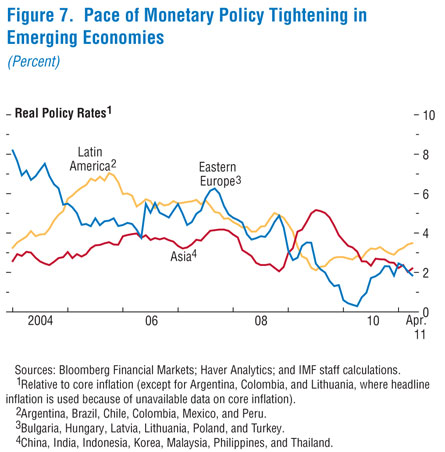
Advanced economies must also address the financial sector vulnerabilities that were at the root of the crisis. In this regard, the situation is more critical in various European economies than elsewhere. In the euro area periphery, there is no way around ambitious structural reforms to boost competitiveness and revive employment growth, along with front-loaded fiscal adjustment and balance sheet repair to restore market confidence and ameliorate the pressure on sovereign and bank spreads. These efforts need to be flanked with concrete steps to strengthen EU-wide supervision and crisis resolution, including by making the safety net more flexible.
In advanced economies with still-sizable economic slack and continued drag from fiscal and financial sector consolidation, monetary policy should stay accommodative—this includes the United States, Japan, and the euro area. As the recovery proceeds and economic slack diminishes more broadly, however, central banks must guard against further increases in core inflation. Importantly, accommodative monetary policy cannot become a substitute for insufficient financial sector repair. In the meantime, macroprudential policies and stronger financial supervision can help contain risks flowing from a prolonged period of low interest rates.
In a number of emerging and developing economies that are already operating at or above precrisis levels of output, the priority is to expeditiously tighten macroeconomic policies, and use exchange rate flexibility and macroprudential tools, possibly including capital controls, to help contain risks of boom-bust cycles. While many emerging and developing economies are already raising policy rates, real rates still remain low. Thus, policy tightening must continue, coordinated with transparent central bank communication to anchor inflation expectations. Economies with high fiscal deficits or debt also need to rebuild room for fiscal policy maneuver, especially those that are susceptible to external shocks or have sharply widening current account deficits (or currencies approaching overvaluation ranges). At the same time, social sector spending and priority infrastructure investment must be preserved. For economies with excessive current account surpluses, particularly in Asia, demand rebalancing—through exchange rate appreciation and structural reforms—remains a top priority for securing balanced growth and employment gains in the medium term.


